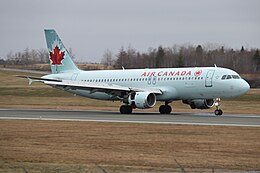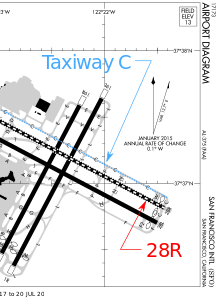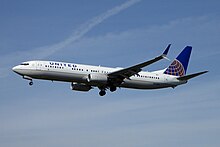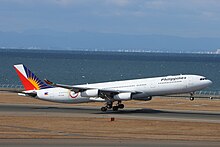
San Francisco International Airport is the primary international airport serving the San Francisco Bay Area in California, United States. It is located in San Mateo County.

Santa Barbara Municipal Airport is 7 miles west of downtown Santa Barbara, California, United States. The airfield covers 948 acres (384 ha) of land and has three runways.

On the evening of February 1, 1991, USAir Flight 1493, a Boeing 737-300, collided with SkyWest Airlines Flight 5569, a Fairchild Swearingen Metroliner turboprop aircraft, upon landing at Los Angeles International Airport (LAX). As Flight 1493 was on final approach, the local controller was distracted, though air traffic was not heavy at LAX, by a series of abnormalities, including a misplaced flight progress strip and an aircraft that had inadvertently switched off the tower frequency. The SkyWest flight was told to taxi into takeoff position, while the USAir flight was landing on the same runway.

Billings Logan International Airport is in the western United States, two miles northwest of downtown Billings, in Yellowstone County, Montana. It is the fourth largest airport in Montana, having been surpassed in recent years by Bozeman, Missoula, and Flathead County (Kalispell) in both number of gates as well as annual enplanements. Owned by the city of Billings, the airport is on top of the Rims, a 500-foot (150 m) cliff overlooking the downtown core, and covers 2,500 acres of land.

Pan Am Flight 845 was a Boeing 747-121, registration N747PA, operating as a scheduled international passenger flight between Los Angeles and Tokyo, with an intermediate stop at San Francisco International Airport.
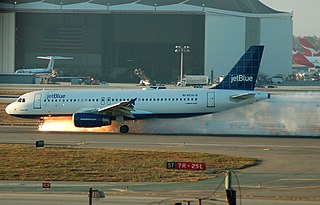
JetBlue Flight 292 was a scheduled flight from Bob Hope Airport in Burbank, California, to John F. Kennedy International Airport in New York City. On September 21, 2005, Captain Scott Burke executed an emergency landing in the Airbus A320-232 at Los Angeles International Airport after the nose gear jammed in an abnormal position. No one was injured.

Montgomery-Gibbs Executive Airport, formerly known as Montgomery Field and Gibbs Field, is a public airport in San Diego, California, United States, six miles (10 km) north of downtown San Diego. The airport covers 456 acres (185 ha) and has three runways, one public and two private helipads. The runways are 28 Right/10 Left-28 Left/10 Right parallels and 05/23.

Treasure Coast International Airport is a public airport located three miles (5 km) northwest of the central business district of Fort Pierce, a city in St. Lucie County, Florida, United States. It is owned by the St. Lucie Board of County Commissioners.

Indian Airlines Flight 605 was a scheduled domestic passenger flight from Bombay to Bangalore. On 14 February 1990, an Airbus A320-231 registered as VT-EPN, crashed onto a golf course while attempting to land at Bangalore, killing 92 of 146 people on board.

The 2007 San Francisco International Airport runway incursion occurred around 1:36 p.m. PDT on May 26, 2007, when SkyWest Airlines Flight 5741, an Embraer EMB 120 Brasilia turboprop aircraft, nearly collided with Republic Airways Flight 4912, an Embraer 170 Regional Jet, at the intersection of Runways 1L and 28R at San Francisco International Airport (SFO).

TAM Airlines Flight 3054 (JJ3054/TAM3054) was a regularly scheduled domestic passenger flight operated by TAM Airlines from Porto Alegre to São Paulo, Brazil. On the evening of July 17, 2007, the Airbus A320-233 serving the flight overran runway 35L at São Paulo during moderate rain and crashed into a nearby TAM Express warehouse adjacent to a Shell gas station. The plane exploded on impact, killing all 187 passengers and crew on board, as well as 12 people on the ground. An additional 27 people in the warehouse were injured. This crash surpassed Gol Transportes Aéreos Flight 1907 as the deadliest aviation accident in Brazilian territory and in South American history and was the deadliest involving the Airbus A320 series until the bombing of Metrojet Flight 9268 in 2015 which killed 224.

TACA Flight 390 was a scheduled flight on May 30, 2008, by TACA International from San Salvador, El Salvador, to Miami, Florida, United States, with intermediate stops at Tegucigalpa and San Pedro Sula in Honduras. The aircraft, an Airbus A320-233, overran the runway after landing at Tegucigalpa's Toncontín International Airport and rolled out into a street, crashing into an embankment and smashing several cars in the process.
Northwest Regional Airport is a privately owned, public use airport 3 nautical miles (5.6 km) northwest of Roanoke, in Denton County, Texas, United States.

XL Airways Germany Flight 888T (GXL888T) was an acceptance flight for an Airbus A320 on 27 November 2008. The aircraft crashed into the Mediterranean Sea, 7 km off Canet-en-Roussillon on the French coast, close to the Spanish border, killing all seven people on board.

Continental Airlines Flight 1404 was a Continental Airlines domestic flight from Denver International Airport in Denver, Colorado, to George Bush Intercontinental Airport in Houston, Texas. On the evening of December 20, 2008, the flight crashed while taking off from Denver, resulting in two critical injuries, 36 noncritical injuries, and a hull loss of the Boeing 737-500 aircraft.

The 1990 Wayne County Airport runway collision involved the collision of two Northwest Airlines jetliners at Detroit Metropolitan Wayne County Airport on December 3, 1990. Flight 1482, a scheduled Douglas DC-9-14 operating from Detroit to Pittsburgh International Airport, taxied by mistake onto an active runway in dense fog and was hit by a departing Boeing 727 operating as Flight 299 to Memphis International Airport. One member of the crew and seven passengers of the DC-9 were killed.
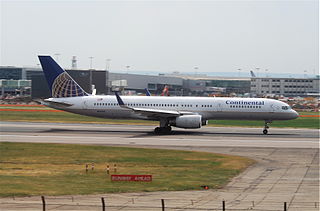
Continental Airlines Flight 1883 was a Boeing 757 that mistakenly landed on a taxiway at Newark Liberty International Airport on the evening of October 28, 2006. There were no reported injuries or damage, but the narrowly averted disaster was investigated by the National Transportation Safety Board, and caused the Federal Aviation Administration to reevaluate and modify air and ground safety procedures at and around Newark Airport.

Asiana Airlines Flight 214 was a scheduled transpacific passenger flight originating from Incheon International Airport near Seoul, South Korea. On the morning of July 6, 2013, the Boeing 777-200ER operating the flight stalled and crashed on final approach into San Francisco International Airport in the United States. Of the 307 people on board, three died; another 187 were injured, 49 of them seriously. Among the seriously injured were four flight attendants who were thrown onto the runway while still strapped in their seats when the tail section broke off after striking the seawall short of the runway. It was the first fatal crash of a Boeing 777 since the aircraft type entered service in 1995.

Air Canada Flight 624 was a scheduled Canadian domestic passenger flight from Toronto Pearson International Airport to Halifax Stanfield International Airport in Halifax, Nova Scotia. During heavy snow and poor visibility, at 00:43 ADT on 29 March 2015, the Airbus A320-211 landed short of the runway and was severely damaged. Twenty-six people were injured.
